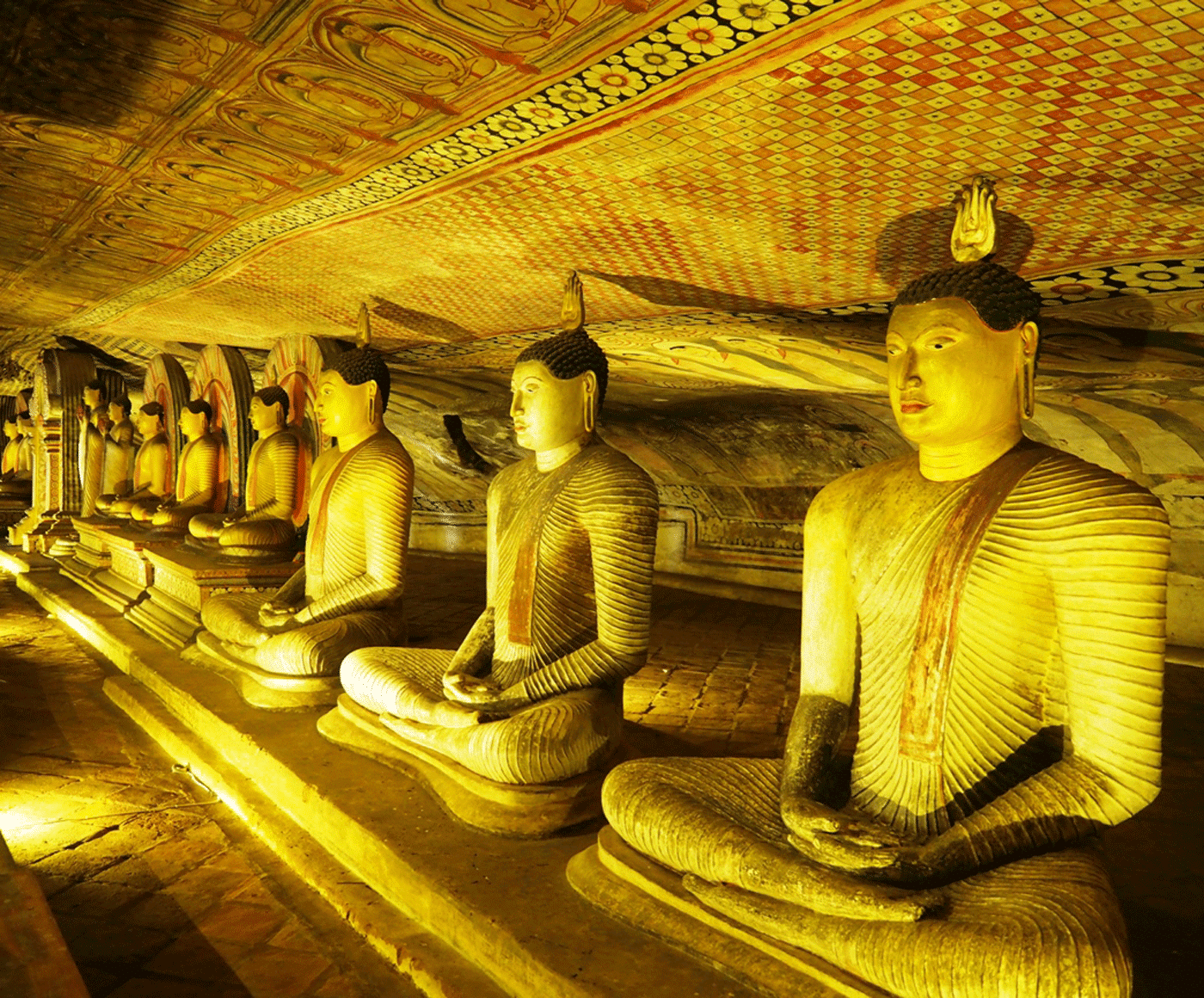Climbing to the top of Sigiriya (Lion Rock) is a must-do in Sri Lanka. The massive stone monolith with steep vertiginous metal stairs attached to its vertical walls draws crowds despite its demands. I had told our guide that we were reasonably fit and up for moderate hiking. Then I spied that giant rock and was ready to wimp out. It was hot, very hot and there were no shade trees leading up to the summit. It was also crowded with a single file line of slowly moving bodies inching upwards. It did not look like fun. Was it worth it? Could I make it?
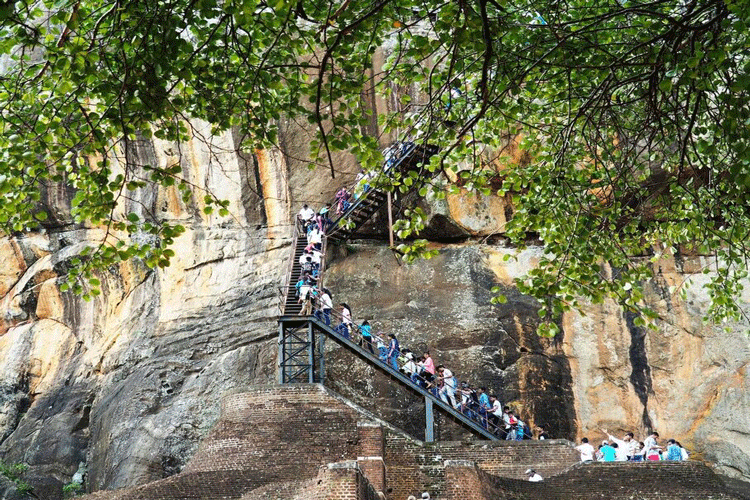
“You can do it,” our guide Nimal assured us; so, we forged ahead. Fortunately, a landing with a gallery of remarkable frescoes provided a welcome break half way up. The reward, stunning vistas at the top, was well deserved. It is generally believed that Sigiriya was a royal citadel during the fifth century, although another theory maintains that it was a monastery and religious site. Our guide adhered to the citadel theory and told us that King Kassapa had 500 concubines, for whom he built swimming pools with diving boards.
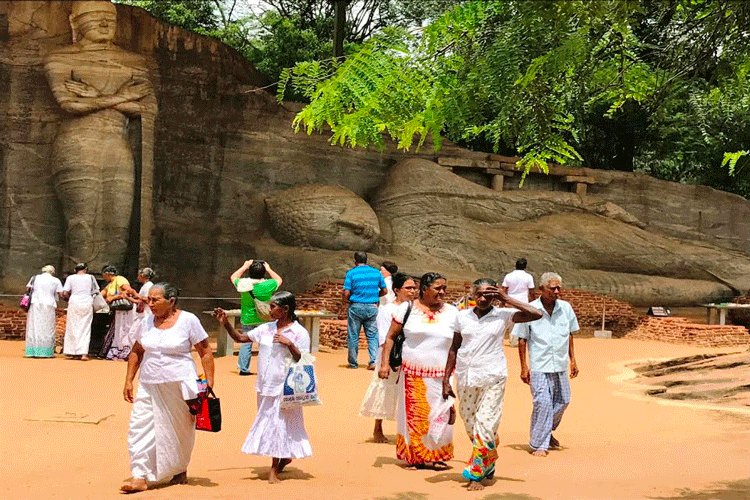
Memorable Sights
There are many more astonishing sights in Sri Lanka, an island nation in the Indian Ocean off the southeast coast of India. Although not much bigger than Wales, Sri Lanka packs a lot into its small area: glorious beaches, ancient temples, hillside tea plantations, wildlife sanctuaries, rain forested peaks, and even more challenging climbs. The country’s 30-year civil war, which ended in 2009, had kept visitors away but that certainly is no longer the case. At Sigiriya, and just about everywhere we went during our two-week tour of the country, we encountered lots of tourists.
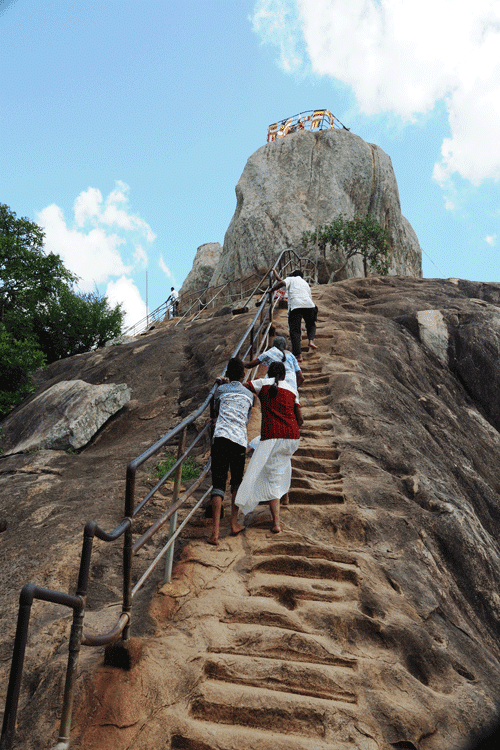
Remarkable Temples
We visited many other sites, temples and ruins. The city of Anuradhapura, Sri Lanka’s ancient capital, is an entire complex of archaeological and architectural treasures. We followed a parade of worshipers walking with a giant piece of orange cloth, 300 meters long. We were told it symbolized Buddha’s skin and was to be wrapped around Ruvanvelisaya, a magnificent white dagoba or shrine for sacred relics. The climb at Mihinthale, another temple complex, was beyond us: 1,843 granite slab steps with the sun blazing down on them. No shoes allowed –you had to ascend barefoot. No way!
Polonnaruwa was Sri Lanka’s medieval capital from the 11th to the 13th centuries and we toured the area by bicycle with stops to admire and photograph. The major attraction is the site with colossal Buddhas carved out of a rock wall.
At Dambulla Royal Rock Temple, some 150 different Buddhas are enshrined in five caves. The Disney-like entrance to the site, with a monstrous Golden Temple, seems out of place, but the gentle climb along a wooded path to this hilltop temple complex is easy and pleasant. Entrance to the caves is controlled with a certain number admitted for each visit. It is well worth the wait to see these remarkable statues in the dimly lit, mystical ambience.
Intriguing Cultures
Both tourists and worshipers flock to Kandy, a lovely hilly town whose magnet is the Sacred Tooth Temple. This is where one of Buddha’s teeth is said to be hidden inside a golden shrine or casket which in turn contains six more caskets, much like a Russian box. We joined a large crowd and patiently waited in line for a night time opening of the heavily guarded room containing the shrine, and then came our turn to file by the relic casket. Although there was little to see, the holy ritual and huge temple complex were both intriguing.
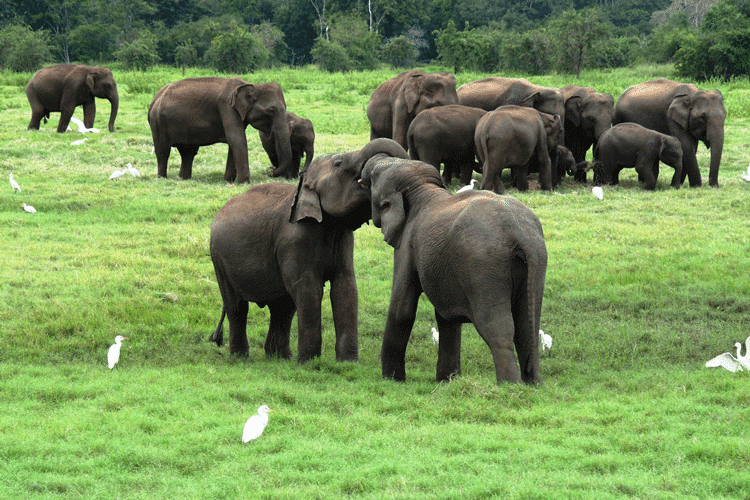
Wildlife in the National Parks
As a cat lover (big and small), my voyage to Sri Lanka was filled with hopes of spotting a leopard. Sri Lanka’s Yala National Park is said to be home to at least 25 of these felines and we visited it along with two others. Sadly, no leopard showed us his spots, but we did see elephants, a spotted deer, a wild boar, a mongoose, turtles, and a sloth bear, a rare sighting according to the guide. We also saw lots of birds including numerous peacocks. Sir Lanka is a paradise for birders with 400 distinct species, 26 of which are unique to the country.

Some 4,000 Asian elephants, an endangered species, make their home in the tiny nation and herds of 200 or more are a common sight in August and September in Minneriya National Park. The herds we saw were much smaller, 25 to 30, but fascinating. The pachyderms are accustomed to tourists and come very close to the safari vehicles. Guides know many of them by name. Elephants need about five square kilometers each to support their 200 kilograms per day appetites. Deforestation and over development in Sri Lanka have diminished their habitat. As in Africa, they encroach on farmland. As in Africa, it’s elephants vs. humans, a challenging conflict.
Turtle Havens
On a visit to a turtle hatchery we learned about the island’s sea turtles which lay their eggs along the coast. Eggs not collected by poachers (turtle egg omelettes are popular) hatch after several weeks and hundreds of baby turtles make their perilous way to the sea. Few survive with many being devoured by fish and birds. At a hatchery eggs are collected then hatched in an incubator. After just one day, they are released into the sea at night. Even using this method, only one in 100 survive, about the same as in nature. The hatchery we visited had been started in 2000 by the current owner’s father who died shortly afterward. It was then that his sister took over but sadly in 2004 she and another sister as well their children and his mother all perished in the devastating tsunami which ravaged the country, killing roughly 40,000 people. The owner and his surviving brother decided to refurbish the hatchery and reopen it.
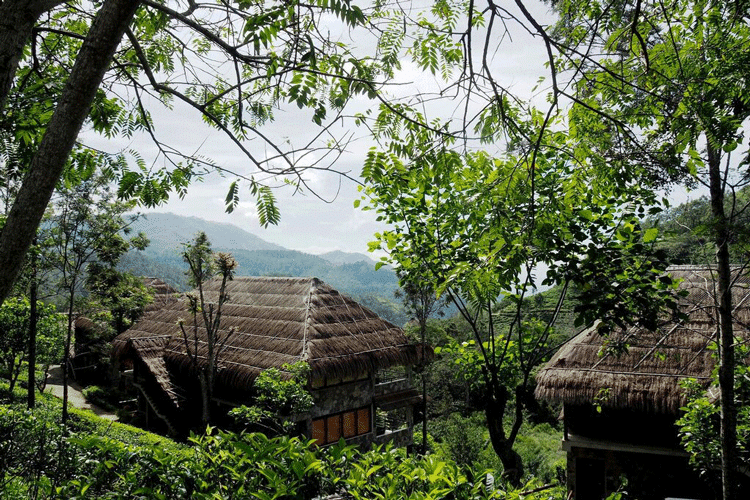
Culinary Adventures Big and Small
No doubt more popular than its animals and safari parks are Sri Lanka’s beaches. They are indeed grand, but the mountainous interior was my favorite. We spent two nights in the hills above Ella, a picturesque area of tea plantations with splendid views, hiking trails and cooler temperatures … a paradise. In the valley below, culinary adventure awaited. I love to savor ethnic tastes and try to incorporate a cooking lesson into my travels. A course in the home of Chef Iran near Ella was perfect. Sri Lankan food is not for sissies. It’s HOT! We watched and helped Iran prepare seven different dishes, and he adjusted the spices (i.e. the heat factor) to our western palates. The full meal with all his delicacies was fabulous and we found it just right on the heat scale.
Throughout our two-week itinerary in the country, we frequently stopped at simple restaurants where buffets were the norm. Our guide and driver Nimal would check with the kitchen staff about the numerous dishes, then tell us which to avoid — the ones with a fire factor of at least four hot peppers. There were many. Even some of the milder ones were too much … maybe we were sissies after all? Hotel restaurants, which cater to international visitors, offer both Sri Lankan favorites and western fare. Sometimes there you’ll find the local specialties toned down a bit, but not always. After setting my mouth aflame more than once, I learned to start with tiny tastes.
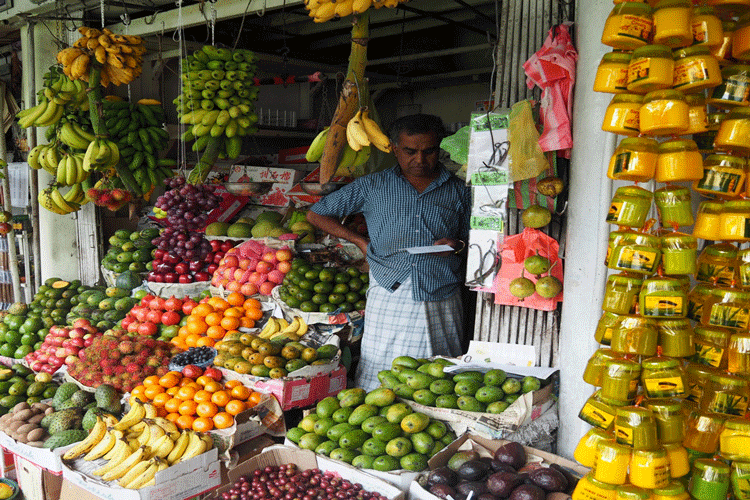
The island nation offers an abundance of fish, exotic fruits, including 20 various kinds of bananas, all manner of vegetables — and spices galore. Cloves, cardamom, cinnamon, pepper, nutmeg, mace, tamarind and vanilla are among the Spice Island’s notable products. They grow in abundance all over the island in fertile and diverse soil types and varying temperatures and are important exports. Yet it’s chilies which are consumed the most and are a key ingredient in the national dish of rice and curry, which Sri Lankans eat three times per day. It can be made with meat, fish or vegetables, and usually has coconut milk and a blend of spices which enhance the dish with intense and exotic flavors.
A Mix of Religious Cultures
Sri Lanka is a land of many religions with Buddhists, Hindus, Muslims and Christians known to visit the same pilgrimage sites. Many people are vegetarians, although it’s not necessarily because of religious restrictions. Nimal said his family did not eat beef. “Cows are gentle animals and give us milk. No need to eat them.” They also reject pork because (as he quoted,) “pigs are dirty animals.”
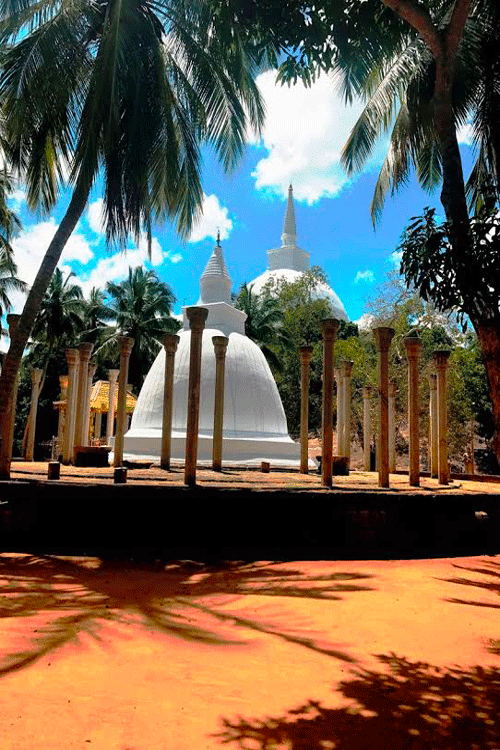
Roaming the Local Markets
The best places to experience the bounty of Sri Lanka are its markets. During our travels we visited several, all vibrant scenes bursting with color and hectic activity. At the Pettah markets in Colombo huge trucks overloaded with produce drove through lanes crowded with shoppers. At the vast Dambulla Wholesale Produce market, once can see an incredible variety of produce but must stay out of the way of frantic workers. A vendor at the market in Kandy gave us samples of fruits we were not familiar with — mangosteen and red bananas. And I purchased spices there for myself and friends.
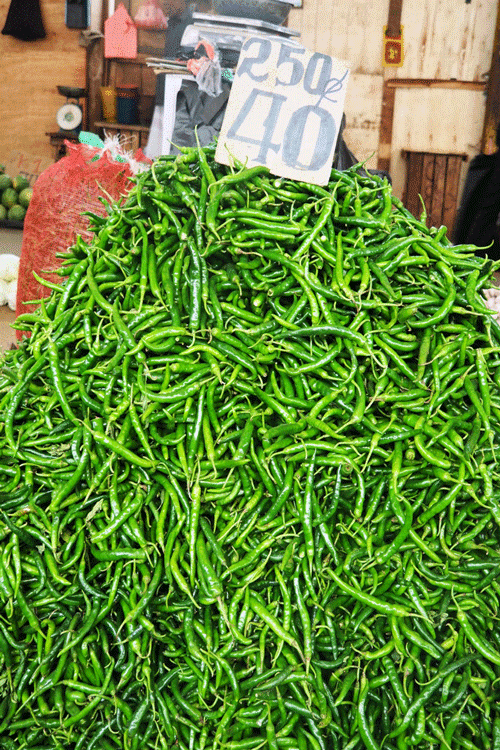
When I recently used some of those spices to make Iran’s Chicken Curry, an incredibly tasty dish, I experienced a euphoric déjà vu of this fascinating, splendid land that lasted for days.
The country code for Sri Lanka is 94.
[alert type=white]
Where to stay:
Jetwing St. Andrews Hotel – Sri Lanka was a British colony until 1948 and the town Nuwara Eliya which is surrounded by tea plantations is often called Little England. Some of the old buildings do seem more British than Sri Lankan, as does this hotel, an old mansion that was a favorite destination for Colonial rulers. Located on the edge of town, it has a real feel of old England. A cozy bar is reminiscent of a pub in the country. High tea is served on the lawn and the breakfast is English – Bacon and Eggs. It was cool when we arrived, and we were welcomed with a roaring fire in the fireplace.
Contact Information: No. 10 Road, Nuwara Eliya 22200, Sri Lanka, +94 522 223 031 www.jetwinghotels.com/jetwingstandrews/
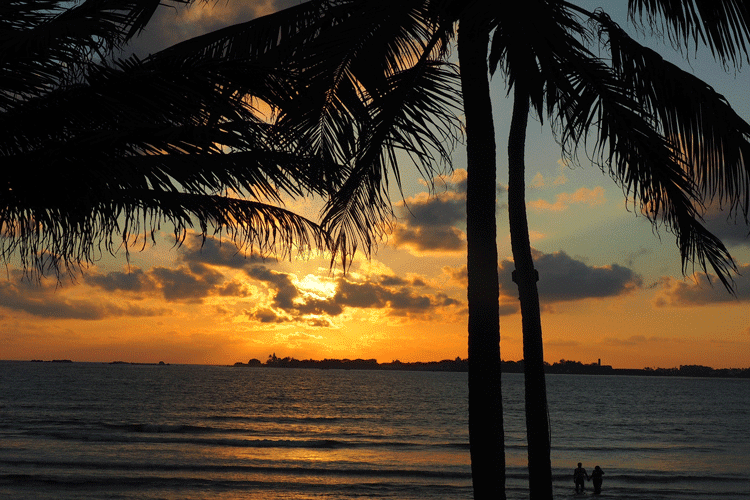
Coco Bay Resort Unawatuna – A boutique style hotel with a stunning location on the serene blue waters of the Indian Ocean. Rooms all have fabulous sea views. Dine outdoors at the edge of a semi-private sandy beach at sunset. The hotel also has a pool and aqua gym and is a terrific location for visiting nearby Galle Fort, a UNESCO World Heritage site.
Contact Information: No: 10/4, Roomassala Road, Roomassala, Unawatuna Beach, Unawatuna, Galle. Sri Lanka. +94 91 2250560/1; +94 91 7423300/4
https://cocobayunawatuna.com/
What to See & Do:
Hire a Tour Guide – Nimal De Silva, our guide and driver, arranges tours of the country. (ndsilva67@gmail.com and info@dsltours.com),
Visit the Heritage Temples – www.srilanka.travel
Take a Cooking Course – For information on cooking lessons with Iran: irankarannagoda@gmail.com
[/alert]

